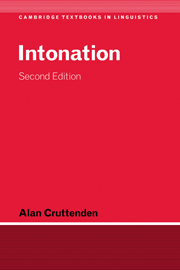2 - STRESS, ACCENT, AND RHYTHM
Published online by Cambridge University Press: 05 June 2012
Summary
Stress and accent
In chapter 1 the articulatory and acoustic correlates of the perceived phonetic features of pitch, length, and loudness were discussed. The justification for concentrating on these three features was that they are all used to make some syllables more prominent in words and in sentences. Perceptual experiments have clearly shown that, in English at any rate, the three features form a scale of importance in bringing syllables into prominence, pitch being the most efficacious, and loudness the least so. The importance of length varies in fact across languages, depending on whether a language uses length for phonemic contrasts on the segmental level; if it does, then loudness will take over from length as the second most important indicator of prominence.
The terms ‘stress’ and ‘accent’ were also introduced in chapter 1, although no systematic difference was made in the use of the three terms ‘prominence', ‘stress’ and ‘accent'. In the past the word ‘stress’ has been used in different and confusing ways. It has sometimes been used simply to refer to syllables (or vowels) made prominent for linguistic purposes, either in words or in sentences. But stress has also often been used to mean ‘breath-force or loudness’ the implication being that this is the principal means whereby syllables are made prominent. This second type of usage is misguided since, as indicated in the last paragraph, loudness generally plays a minor role in producing prominences.
- Type
- Chapter
- Information
- Intonation , pp. 13 - 25Publisher: Cambridge University PressPrint publication year: 1997



